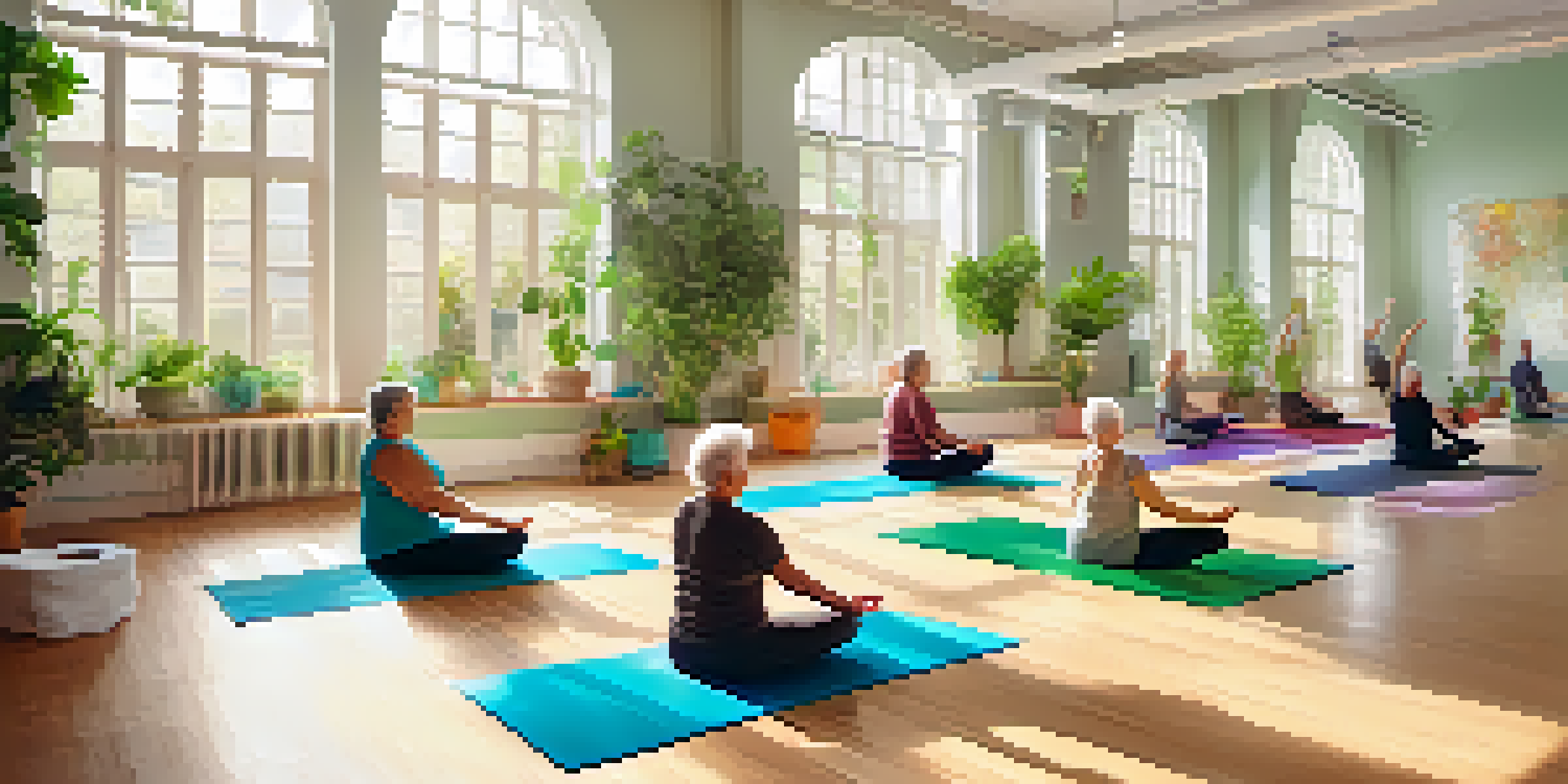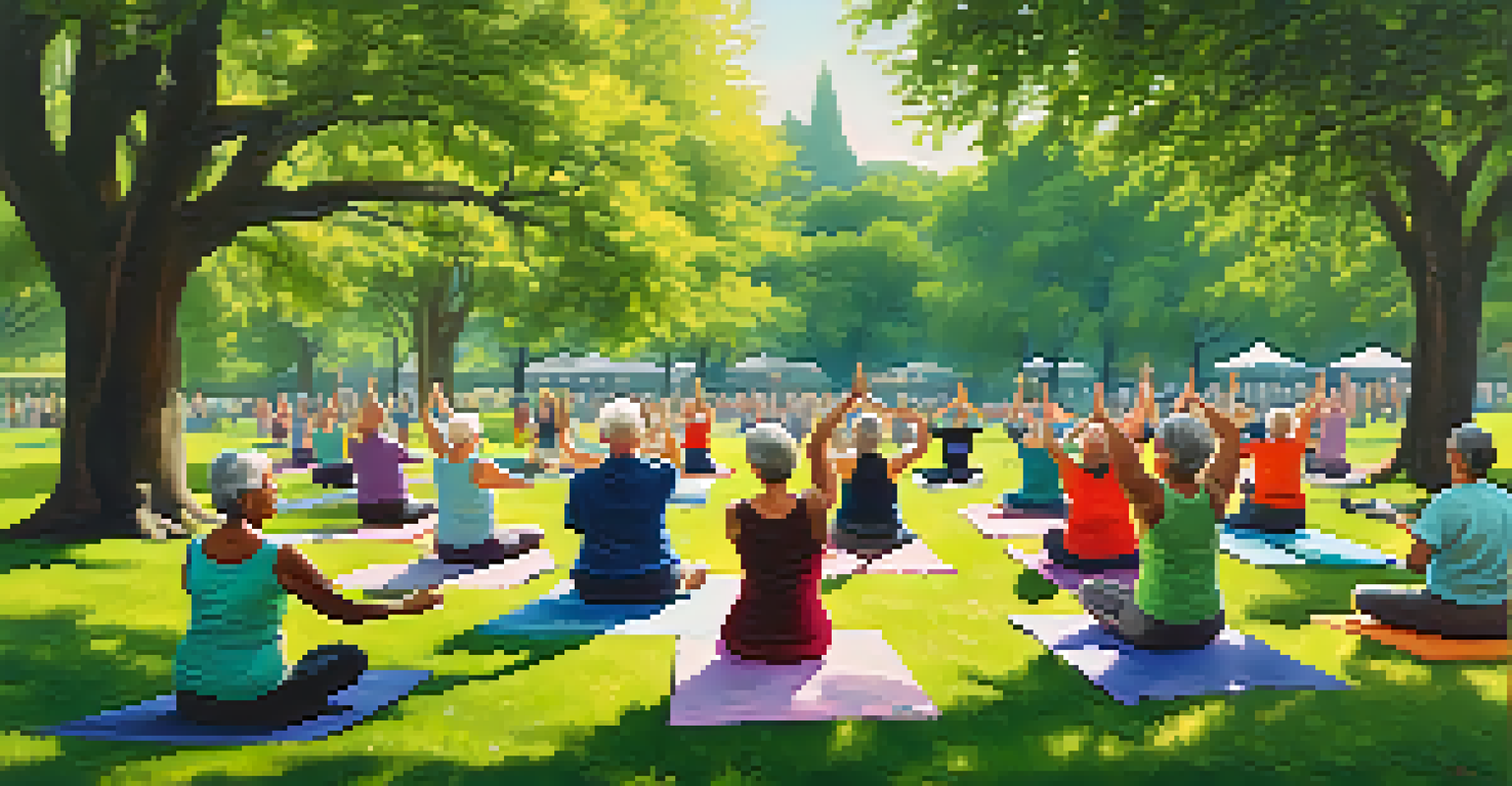The Benefits of Yoga for Seniors: Staying Active and Flexible

Understanding Yoga: A Gentle Path to Wellness for Seniors
Yoga is more than just a physical exercise; it's a holistic practice that combines movement, breath, and mindfulness. For seniors, it offers a gentle way to stay active, promoting both physical and mental wellness. This ancient discipline encourages relaxation and stress relief, which can be incredibly beneficial in our golden years.
Yoga is the journey of the self, through the self, to the self.
Many people may think yoga is only for the young and flexible, but the truth is, it can be adapted for all ages and abilities. With a variety of styles ranging from restorative to chair yoga, every senior can find a practice that suits their needs. It's about meeting oneself where they are on their wellness journey.
Ultimately, yoga fosters a sense of community and belonging, which is crucial as we age. Joining a class can introduce seniors to new friends and provide a supportive environment, enhancing both social connections and overall happiness.
Improving Flexibility: A Key Benefit of Yoga for Seniors
One of the most significant benefits of yoga is improved flexibility. As we age, our muscles and joints can become stiff, making daily activities more challenging. Regular yoga practice helps to stretch and lengthen these muscles, promoting greater ease of movement.

Think of flexibility in yoga as oiling the hinges of a door; it allows for smoother operation. Poses like downward dog and seated forward bend gently stretch various muscle groups, gradually increasing the range of motion. This not only helps in yoga but also translates into everyday activities, such as bending to tie your shoes or reaching for items on a high shelf.
Yoga Enhances Physical Wellness
Yoga promotes improved flexibility, strength, and balance, helping seniors maintain an active lifestyle.
Incorporating flexibility-focused yoga into a regular routine can lead to fewer injuries and a more active lifestyle. The more flexible you are, the easier it becomes to maintain independence as you age, allowing you to enjoy life to the fullest.
Enhancing Balance: Yoga's Role in Fall Prevention
Balance becomes increasingly important as we age, and yoga can play a significant role in enhancing it. Many yoga poses focus on stability, helping seniors improve their coordination and reduce the risk of falls. Poses like tree pose and warrior III build strength in the legs and core, which are essential for maintaining balance.
The mind is everything. What you think, you become.
Imagine standing on one leg while reaching for something on a shelf; good balance makes this task achievable. Regular practice can help seniors feel more grounded and confident in their physical abilities. This newfound stability can encourage more active participation in daily life.
By working on balance through yoga, seniors can also regain confidence in their movements. This improvement not only helps prevent falls but can also reduce the fear of falling, allowing for a more vibrant and engaged lifestyle.
Boosting Strength: Building a Stronger Body Through Yoga
While yoga is often associated with stretching and relaxation, it also plays a crucial role in building strength. Many poses require the use of body weight to strengthen muscles, which is particularly beneficial for seniors. Poses like plank and chair pose engage multiple muscle groups, promoting overall strength.
Think of strength training in yoga as building a solid foundation for a house. The stronger the foundation, the more stable the structure. This foundation is vital for maintaining mobility and performing daily activities with ease.
Mindfulness Supports Mental Health
Incorporating mindfulness techniques in yoga can alleviate stress and anxiety, enhancing emotional well-being for seniors.
By incorporating strength-building yoga into their routine, seniors can enhance their physical capabilities and improve their overall quality of life. Increased strength can lead to greater independence, allowing seniors to perform tasks without assistance.
Mindfulness and Relaxation: Mental Health Benefits of Yoga
Yoga is not just a physical workout; it's also a practice of mindfulness and relaxation. For seniors, incorporating mindfulness techniques can help alleviate stress, anxiety, and depression. The meditative aspect of yoga encourages individuals to focus on the present moment, creating a sense of calm.
Imagine taking a few deep breaths and letting go of all your worries; that's the essence of mindfulness in yoga. This practice can lead to improved emotional well-being, which is essential for maintaining a positive outlook as we age.
By integrating mindfulness into their daily routine, seniors can experience improved mental clarity and emotional resilience. This not only enhances their yoga practice but also contributes to a more fulfilling and joyful life.
Social Connections: Building Community Through Yoga
Joining a yoga class can be a fantastic way for seniors to build social connections. Group classes create an opportunity to meet new people, share experiences, and foster friendships. This sense of community can significantly enhance one's quality of life, combating feelings of loneliness and isolation.
Think about it: sharing a yoga mat with others can lead to shared laughter, encouragement, and support. These social bonds can be incredibly uplifting, providing motivation to stay committed to a regular practice.
Community Builds Connections
Joining yoga classes fosters social connections, combating loneliness and enriching seniors' lives through shared experiences.
Engaging with others in a supportive environment not only enriches the yoga experience but also creates lasting relationships. The friendships formed in these settings can lead to social activities outside the class, promoting a more active and connected lifestyle.
Finding the Right Yoga Class: Tips for Seniors
Finding the right yoga class can feel overwhelming, especially for seniors new to the practice. It's essential to seek out classes designed specifically for older adults or those that offer gentle modifications. Look for terms like 'gentle yoga' or 'chair yoga' in class descriptions to ensure a suitable experience.
Many community centers, gyms, and studios offer specialized classes tailored to the needs of seniors. Attending a few different classes can help individuals find the right instructor and class style that resonates with them. Don't hesitate to ask questions or discuss any concerns with the instructor before starting.

Ultimately, the goal is to find a practice that feels comfortable and enjoyable. By exploring various options, seniors can discover a yoga community that meets their needs and enhances their well-being.
Getting Started: Tips for Seniors New to Yoga
Starting a yoga practice as a senior can feel daunting, but it’s easier than you might think! Begin by consulting with your healthcare provider to ensure that yoga is a safe option for you. Once you receive the green light, consider attending a beginner class to learn the basics in a supportive environment.
It's also helpful to invest in a good yoga mat and comfortable clothing to make your practice enjoyable. Remember, yoga is about listening to your body and moving at your own pace. You don’t need to impress anyone; focus on what feels good for you.
Lastly, be patient with yourself as you embark on this journey. Progress may be slow, but every session is a step towards better health and well-being. Embrace the process, and soon you'll find that yoga can be a rewarding and transformative experience.